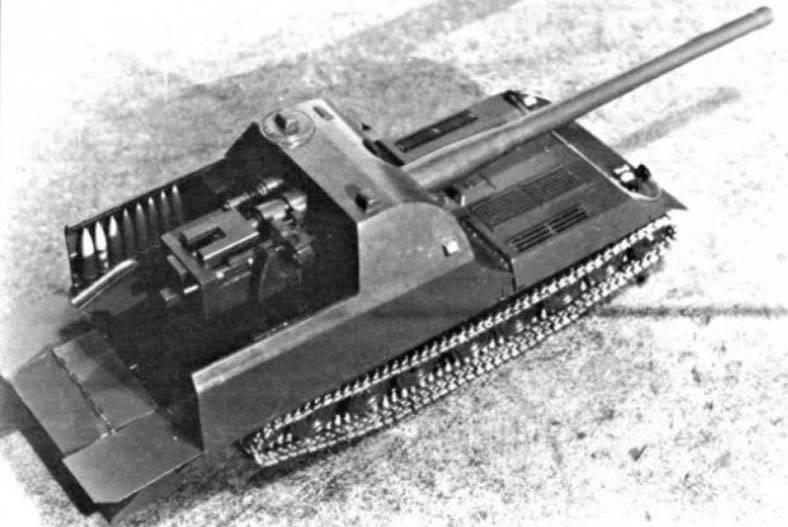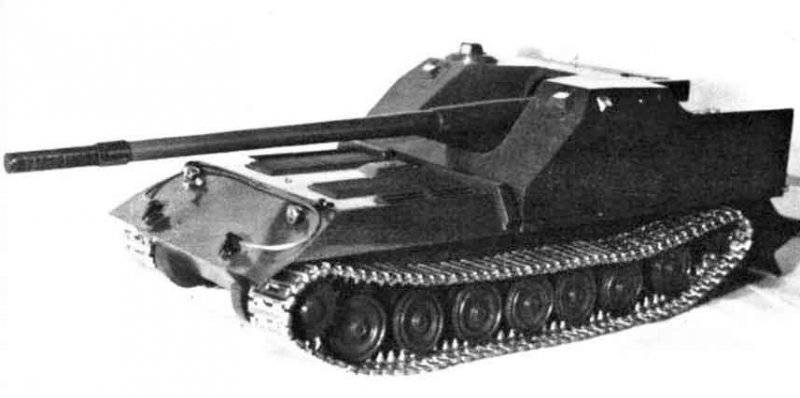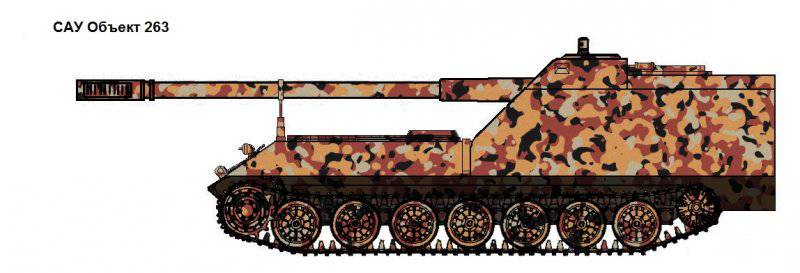Sacrifice own weight. SAU "Object 263"
In this regard, in 1950, the designers of the Leningrad Kirov Plant were tasked with creating on the basis of tank IS-7 heavy self-propelled artillery mount. The project received the designation “Object 263”, and V.S. was appointed the lead designer of the conceptual design. Starovoitov. Initially, three versions of the new self-propelled gun were created, differing from each other in some nuances of the design. In the course of work on “Object 263”, these options were often “exchanged” with various nuances of the design, and as a result, only one version remained in the program, which predicted a great future.
Since one of the main requirements for the new ACS was maximum unification with the EC-7 tank, its running gear was borrowed almost unchanged. The engine-transmission group remains the same: the 12-cylinder V-shaped diesel M-50T with horsepower 1050 and a six-speed gearbox. The same can be said about the suspension, rollers and tracks. In this case, the overall layout of the body has been significantly adjusted. Armored self-propelled cabin was to be located in the rear of the hull, so the engine and transmission were transferred to the front. The fuel tanks, in turn, are now located in the middle part of the armored hull. The change in the alignment of the machine associated with the repackage was offset by an increase in the thickness of the armor. First of all, the forehead of the “263 Object” should be noted. Unlike the forehead of the IS-7 tank, it was not made on the “pike nose” system, but was a simple combination of rectilinear panels. The main plus of the location of armored panels at an angle to each other is to increase the level of protection compared to “direct”. For this reason, the “263 Object” was proposed to be equipped with a frontal sheet with a thickness of 300 millimeters. The hull sides in the project had a much smaller thickness, from 70 to 90 mm. As for the armored cabin, it also had solid protection: a frontal sheet in 250 mm and sides on 70 mm. With such armor, the 263 Object could withstand shelling from all existing cannons of medium tanks and a number of more serious guns.
The main armament of the self-propelled artillery "Object 263" was supposed to be a gun C-70A. In fact, this was a further development of the C-70 cannon designed for the EC-7 tank. This project, created in the Central Artillery Design Bureau under the direction of VG Grabina ascended to the pre-revolutionary naval cannon B-7 caliber 130 millimeters. It is worth noting that in the course of several deep upgrades, the design of the gun was significantly modified and the C-70А had almost nothing in common with the original B-7 besides the caliber. The C-70A gun had solid dimensions, primarily caused by an 57,2 caliber barrel. In addition, the breech and recoil devices were no small. Because of this, the layout of the cabin was quite unusual. The breech of the gun almost reached the rear wall of the cabin. For this reason, the latter had to be folded. It was assumed that before the start of the battle the crew would lower this part and be able to work without fear of damage to the cabin. In addition, the folded rear sheet slightly increased the floor space of the crew compartment, which could slightly ease the work of the crew.
The 130 mm gun had a very high recoil. Therefore, to the muzzle brake of the slit system and recoil devices, it was necessary to add a flip-down support device resembling a dozer blade. On the existing photos of the layout of the “263 Object” it can be seen that in the lowest position he kept the lowered forage for felling on himself. Along the sides of the cabin, on their inner side, were placed holders for ammunition. The separate loading shots were fixed on seven from each side. For convenience, the shells were located in one holder, the sleeves - in the other. Loading the gun was the responsibility of two crew members: loader and his assistant.

In total, the crew of the SAU “Object 263” should have included five people: the commander, the driver, the gunner, and two loaders. For direct fire, the crew had a TP-47 sight, and for firing from closed positions it was proposed to equip a self-propelled gun with a TS-46 sight. The estimated rate of fire of the “263 Object” was not large - in a minute the crew could manage to make no more than one to one and a half shots. The main reason for this was the specific layout of the cabin, which did not allow to achieve the indicators that the EC-7 had (about six shots). The low rate of fire, according to the opinion of the military and the developers, was to be compensated by the high firing characteristics of the long-barreled gun. So, from a distance of two thousand meters, the C-70 cannon, when using the BR-482 armor-piercing projectile, had to punch millimeters of homogeneous armor (at an encounter angle of 160 °) to 170-90.
At the beginning of 1951, the draft design of the self-propelled gun was ready, and it was presented to the commission of the Ministry of Defense. The military authorities got acquainted with the works of the LKZ designers, after which the assembly of the full-scale SAU layout began. On the layout, it was planned to check some ideas and identify problems of layout, ergonomics, etc. Just a few weeks after the completion of the layout of the “263 Object” from Moscow, an order came: to stop work on the project. Of course, the 130-mm gun was a very good argument on the battlefield. However, the estimated mass of the new self-propelled artillery installation was at the level of 60 tons. It was on 8000 a kilogram less than that of the recently closed project EC-7, but still too much for practical use in the existing conditions. The construction of self-propelled guns, theoretically, could be facilitated. But only at the cost of reducing the level of protection, which would be far from the most reasonable solution. Due to the combination of advantages and disadvantages, the Main Armored Directorate decided that such equipment was not needed by the Soviet Army. The only constructed layout of the “263 Object” was disassembled, and before the construction “in metal” it never came.
On the materials of the sites:
http://blogtanker.ru/
http://armor.kiev.ua/
http://gosu-wot.com/


Information